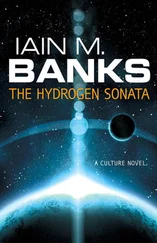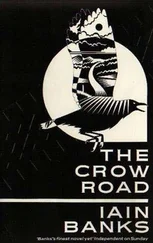“The other?”
“Not so long ago. Helping to pursue a large force of Beyonder ships in the vicinity of Zateki. We prevailed there, too.”
“What brought you to the Sepulcraft Rovruetz?” Fassin asked.
The flat and flattening chink-chink-chink noise stopped. The ginger-haired ape held its breastplate up to catch the light, scratched its chest, then went back to tapping with the hammer again.
“Do you represent a Lustral Investigation Board?” the old man asked. “Is that what you are, in reality?”
“No,” Fassin said. “I don’t.”
“Oh. Oh well. For the last two and a half centuries, uniform time,” the old man said, “we had been seeking information about the so-called Dweller List.” (The long-limbed ape laughed out loud at this, but the old man didn’t seem to notice.) “Much time was spent in the region of the Zateki system, investigating the Second Ship theory. Various secondary and tertiary missions resulted from information gleaned in the region. None ever bore fruit in the matter of the List, the Second Ship theory or the so-called Transform, though two AIs were tracked down and eliminated in the course of these sub-missions. We were summoned from the Rijom system and sent to the Direaliete system some five months ago, then laid an intercept course to the Sepulcraft Rovruetz. I was not told of the reasons for this course of action, the orders covering which were personal to Commander Inialcah and communicated to him beyond my senses.”
“Did you find out anything new about the List and the Transform?” Fassin asked.
“I think the only thing that we ever felt we had properly discovered, in the sense of adding something other than just an extra rumour to the web of myths and rumours that already existed regarding the whole subject was that — if there was any truth in the matter — the portals would be lying quiescent and perhaps disguised in the Kuiper belts or Oort clouds of the relevant systems, waiting on a coded radio or similar broadcast signal. That is what the so-called Transform would be: a signal, and the medium and frequency on which it was to be transmitted. This made sense in that all normally stable locations where portals might have been hidden successfully over the sort of time scales involved — Lagrange points and so on — were easy to check and eliminate.” The old man looked at Fassin quizzically again. “Are you another seeker after the truth of the List?”
“I was,” Fassin said.
“Ah!” The representation of the old man looked pleased for once. “And are you not dead, then, too?”
“No, I’m not dead, though I’ve given up looking, for the moment.”
“What was it that took you to the Sepulcraft Rovruetz?” the old man asked.
“I had what I thought was a lead, a clue, a way forward,” Fassin told him. “However, the creature who might have had the evidence had destroyed what he held and killed himself.”
“Unfortunate.”
“Yes, very.”
The old man looked up at the bronze-blue cloudless sky. Fassin followed his gaze, and as he did so, the old man disappeared.
There was something. Fassin sat, gascraft rammed into the extemporised couch in the Voehn ship’s command space by the continuing acceleration, watching the nearly static, rather boring view of dead ahead shown on the main screen, and he knew there was something that he was missing.
Something nagged at him, something bothered him, something half-came to him in moments of distraction or when he was dreaming, and then wriggled away again before he could catch it.
He didn’t sleep very much — only a couple of hours a day in all — though when he did there were usually dreams, as if his subconscious had to cram all his dreaming into the small amount of dream-space available. Once he was actually standing in a small stream, somewhere in the gardens of a great house he couldn’t see, trousers rolled up, trying to catch fish with his bare hands. The fish were his dreams, even though he was distantly aware at the time that this situation was itself a dream. When he tried to catch the fish — sinuous small presences darting like elongated teardrops of mercury round his feet — they kept flicking away and disappearing.
When he looked up, the stream was flowing through a large amphitheatre, and a great crowd of people were watching him intently.
At the transition point of the journey, where the Protreptic stopped accelerating, turned a half-somersault and pointed its engines at its destination to start deceleration, Quercer Janath spent some time checking that Y’sul was still healing satisfactorily.
Fassin used the time to explore a little more of the Voehn ship, floating the arrowhead gascraft down the narrow circular access tubes, investigating crew quarters, storerooms and chambers. Camera remotes tracked his every move, the thoroughly internally surveillanced ship making it simple for Quercer Janath to keep whatever fraction of an eye on him they thought appropriate.
He found what he thought was probably the commander’s cabin, a couple of bulkheads behind the command space. It was the most generously proportioned obviously personal space he’d encountered. It looked bare and alien. There was a slightly more comfortable version of one of the multi-spine cradle seats he was used to seeing throughout the ship by now, and some representations of coverings on certain walls, plus what might have been carpet designs on the floor. Only the designs existed, painted on or displayed by some thin-film technology — Fassin couldn’t tell. Similarly, there were no ornaments, just holos of ornaments. He’d heard most warships were like this; cutting down on weight and the possibilities of stuff flying about during hard manoeuvring by having the appearance of things rather than their physical presence.
He floated in front of one carpet design that looked like a piece of text, all small, curled glyphs in a network, but could find no record in the gascraft’s memories of such a language. He wondered what it said. He recorded the image. Quercer Janath would probably wipe it when they went through the portal, but never mind.
The next time he met up with the ship, on the far side of the river there was a massive dark wall, rising sheer and jet from the waters, its summit crowned with crenellations and gun turrets. Further guns poked out of gun ports distributed in staggered lines over the whole top quarter of the huge wall, making it look like the side of some ancient sea-ship, only the biggest and most preposterously long one there had ever been, its vast hull diminishing into the distance. The guns were not static but moved in sequence, in waves of what appeared almost like locomotion, making the exposed barrels look oddly like ineffectual oars on some colossally mis-designed trireme or an impossible, upended millipede.
The ginger-haired ape sat nearby as usual. It had a new shield, round and highly polished. It sat looking at it and flicking imaginary specks from it. Sometimes it held it up to see it sparkle in the light, and sometimes it held it up so that it could look at itself in it.
“Text?” the elderly man asked. “On a floor display? No, I’m sorry, I don’t have any memory of that, not stored. If the ship still existed, if I still had access…’ He looked sad. Fassin glanced at the ginger-haired ape, but it looked away and started whistling, or at least trying to.
“Maybe there’s some way I can patch through an image I have,” Fassin said.
“You have an image? You have been on the ship?” The man looked surprised.
After some to-ing and fro-ing, Fassin having to jog back up the step and through the doorway back into normal reality to set things up, he was able to display the image he’d taken. The long-limbed ape held up his shield and the image appeared there.
Читать дальше












